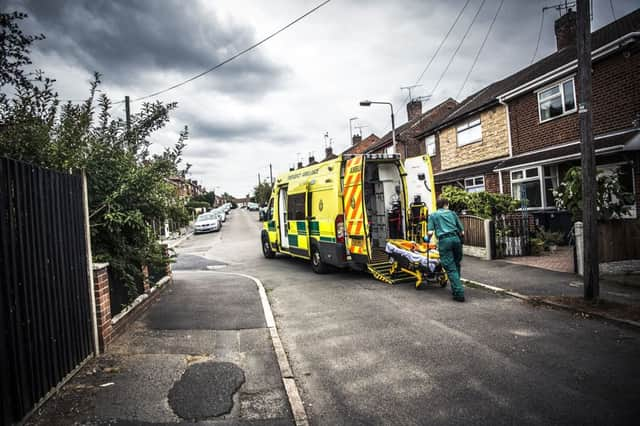SELSTON: Ambulance failure for ‘dying’ patient


Kathleen Harpham was found unconscious on the floor of her Selston home on December 10th last year after suffering a brain haemorrhage, Nottinghamshire Coroners’ Court was told on Monday.
The ambulance took almost 20 minutes to arrive at the scene and was then delayed at Mrs Harpham’s Bridge End Avenue home for a further ten minutes as crews struggled to get the vehicle’s hydraulic footplate back into place before setting off to hospital.
Advertisement
Hide AdAdvertisement
Hide AdCrews also told relatives that the Mercedes ambulance was a replacement, as their regular vehicle had also broken down.
The hearing, at Nottingham Council House, was told that the vehicle’s rear footplate, used to raise patients into the back of the vehicle, would not return to its correct position electronically and a manual handcrank also failed - taking emergency staff much longer to get the 75-year-old to A&E at Kings Mill Hospital.
Giving evidence, ambulance technician Paul Knight told the hearing: “There were some severe difficulties getting the ramp up. My colleague was down at the ramp taking longer than I would have expected, and when I took over the ramp wouldn’t go up as quickly as normal.
“I would say it delayed us by between eight and 10 minutes. Our usual ambulance had broken down on another watch and this one was a replacement.”
Advertisement
Hide AdAdvertisement
Hide AdMrs Harpham died shortly after arriving at Kings Mill with distraught relatives at her side, the inquest heard.
She had been suffering from myeloma - a cancer caused by rogue plasma cells infecting the bloodstream - which had recently developed into terminal leukemia in the weeks before her death.
Professor Nigel Russell from University Hospitals Nottingham NHS Trust, which was responsible for Mrs Harpham’s care, told the hearing that repeated chemotherapy treatments had stopped working he had recommended end-of-life care for the pensioner.
He said: “This is something that was going to happen. She was going to die within a week or two and there was nothing that was going to alter what happened.”
Advertisement
Hide AdAdvertisement
Hide AdThe inquest was told that the Mercedes ambulance was notorious amongst EMAS staff for suffering problems with its hydraulic rear footplate, which was usually rectified by ‘moving the switches’.
The vehicles are now used primarily as spares and are being phased out by EMAS and replaced by a vehicle with a ramp (pictured), which could be lifted into place if it would not raise electronically.
On the day of Mrs Harpham’s death, the ambulance took 19 minutes to arrive as it was travelling from Blidworth and the service was experiencing a very busy period.
EMAS dispatcher Debbie Sturgess said that as it was a life-threatening situation, the vehicle should have arrived in eight minutes. She also said that the 17 minute turnaround at the scene was acceptable.
Advertisement
Hide AdAdvertisement
Hide AdRecording a verdict of death by natural causes, assistant deputy coroner Amanda Cranny said EMAS was currently phasing out the vehicle.
PICTURED: Paramedics operating one of the new generation of ambulances which now uses a tail ramp rather than a hydraulic lift. (C)RyanMonamara2012